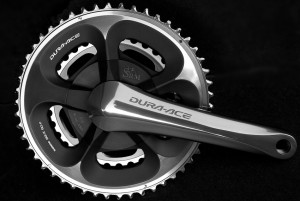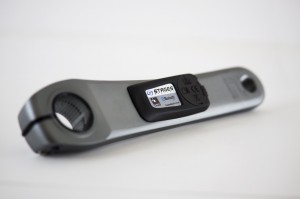 From a training standpoint, coaches and self-coached athletes want the most objective power meter measurement possible. For several years, heart rate monitors were used but remained limited, especially for a short-term effort. Exercise labs possess stationary ergometers, but these aren’t usable for a casual group ride. In recent years, manufactures have stepped up their efforts to fill the expanding market of bicycle specific power meters; the following are different approaches complimented with their pros and cons.
From a training standpoint, coaches and self-coached athletes want the most objective power meter measurement possible. For several years, heart rate monitors were used but remained limited, especially for a short-term effort. Exercise labs possess stationary ergometers, but these aren’t usable for a casual group ride. In recent years, manufactures have stepped up their efforts to fill the expanding market of bicycle specific power meters; the following are different approaches complimented with their pros and cons.
Power Tap was once owned by Tune, but is now property of Cyclops. The device has been improved considerably from its introductory days and remains as the only hub based measuring unit on the market. Power Tap uses the same strain gauge mechanics as many other designs, resulting in the same +/- 1.5% accuracy. Bike to bike moves are easy, and are only a wheel change away. The Power Tap also uses the same popular wireless software (ANT+ Sport) as most other computer head manufactures (such as Garmin) resulting in compatible head units. If you are looking for a device to use on multiple machines, this would be a logical choice. However, if a high-quality racing wheel is needed and power is desired, the hub has to be specially built into it (so no off-the-shelf prebuilt wheels). Unless you wanted to train on this same wheel (which isn’t a usual way to treat an expensive wheel), another training wheel would need to be built, meaning additional cost. Power Tap has recently reduced their pricing significantly, yielding wheels for under $900.
 In the area of crank based meters, there are two choices: SRM and Quarq. The first is also the original; German Uli Schoberer released the first SRM in 1987. In developing this power meter, the strain gauges were placed in the spider arm section of a SRM specified crank. SRM is now using off the shelf high-end cranks, like Shimano’s popular Dura Ace, and engineering them to function as power meters. This allows a bike to keep the consistency of a component group (Dura Ace, Ultegra, etc.) and still measure output power in watts. Unfortunately, SRM does not have a user replaceable battery, therefore the unit must be sent back ever 1900 hours of use for replacement. SRM is testing a rechargeable battery that uses a USB port and needs attention after approximately 300 hours or use, but isn’t in production yet. The SRM can be paired with a 3rd party compatible ANT+ head unit, which allows for technology expansion. However, while most head units create an average by measuring one of the four data points every second, the SRM specific Power Control unit measures all four, then averages them for that second. Thus, for shorter measured durations such as a sprint, the Power Control unit provides more accuracy in power measuring. One common feature not on the Power Control unit is GPS. Additionally, SRM uses only the higher end cranks on the market, resulting in the highest prices, with a range from $2,400 to $4,000.
In the area of crank based meters, there are two choices: SRM and Quarq. The first is also the original; German Uli Schoberer released the first SRM in 1987. In developing this power meter, the strain gauges were placed in the spider arm section of a SRM specified crank. SRM is now using off the shelf high-end cranks, like Shimano’s popular Dura Ace, and engineering them to function as power meters. This allows a bike to keep the consistency of a component group (Dura Ace, Ultegra, etc.) and still measure output power in watts. Unfortunately, SRM does not have a user replaceable battery, therefore the unit must be sent back ever 1900 hours of use for replacement. SRM is testing a rechargeable battery that uses a USB port and needs attention after approximately 300 hours or use, but isn’t in production yet. The SRM can be paired with a 3rd party compatible ANT+ head unit, which allows for technology expansion. However, while most head units create an average by measuring one of the four data points every second, the SRM specific Power Control unit measures all four, then averages them for that second. Thus, for shorter measured durations such as a sprint, the Power Control unit provides more accuracy in power measuring. One common feature not on the Power Control unit is GPS. Additionally, SRM uses only the higher end cranks on the market, resulting in the highest prices, with a range from $2,400 to $4,000.
http://www.srm.de/srm-training-system/what-is-srm/
 The second popular crank-based power meter is the SRAM owned Quarq. This company shipped their first units in mid 2008. Unlike SRM, who incorporates the strain gauges into the one-piece spider/arm of the crank, Quarq looked at the still popular market that had three-piece cranks (spider, left crank arm, right crank arm) and made a replaceable spider that had the necessary electronics. This brought the price down considerably and offered a user replaceable battery, making the product consumer friendly. Quarq offers models using Cannondale, Specialized, and SRAM cranks, and has two new models, the high end Elsa and more affordable Riken. Both have similar electronics, offer the same +/- 1.5% accuracy as other power meters, and no longer need to be recalibrated when chain rings are replaced. The Elsa has lighter crank construction and offers the ability to indirectly measure separate leg strengths. All units use the ANT+ sport licensing, and pricing runs roughly 30 to 40% less then SRMs.
The second popular crank-based power meter is the SRAM owned Quarq. This company shipped their first units in mid 2008. Unlike SRM, who incorporates the strain gauges into the one-piece spider/arm of the crank, Quarq looked at the still popular market that had three-piece cranks (spider, left crank arm, right crank arm) and made a replaceable spider that had the necessary electronics. This brought the price down considerably and offered a user replaceable battery, making the product consumer friendly. Quarq offers models using Cannondale, Specialized, and SRAM cranks, and has two new models, the high end Elsa and more affordable Riken. Both have similar electronics, offer the same +/- 1.5% accuracy as other power meters, and no longer need to be recalibrated when chain rings are replaced. The Elsa has lighter crank construction and offers the ability to indirectly measure separate leg strengths. All units use the ANT+ sport licensing, and pricing runs roughly 30 to 40% less then SRMs.
 A new player on the market is Stages, who began selling their products in 2012. Like other makers, strain gauges are used. However, Stages’ gauges are located in a single, thin pod that is fastened to a brand specific left crank arm, requiring the replacement of the existing crank arm. The process is simple: replace the arm, pair the 20g meter with your head unit of choice, and that’s it. The system multiplies this single power reading by two to get your total power, making the assumption both legs are similar in strength. Stages states only about 5% of the riders have a significant difference. One drawback is that only metal crank arms are offered, which typically means Shimano. A full range of models exist (105, Ultegra, and Dura Ace), and are very reasonably priced at $600 to $900. These systems are ANT + compatible and have the new Bluetooth transmission. Accuracy is rated at +/- 2%, without factoring in any possible leg discrepancies.
A new player on the market is Stages, who began selling their products in 2012. Like other makers, strain gauges are used. However, Stages’ gauges are located in a single, thin pod that is fastened to a brand specific left crank arm, requiring the replacement of the existing crank arm. The process is simple: replace the arm, pair the 20g meter with your head unit of choice, and that’s it. The system multiplies this single power reading by two to get your total power, making the assumption both legs are similar in strength. Stages states only about 5% of the riders have a significant difference. One drawback is that only metal crank arms are offered, which typically means Shimano. A full range of models exist (105, Ultegra, and Dura Ace), and are very reasonably priced at $600 to $900. These systems are ANT + compatible and have the new Bluetooth transmission. Accuracy is rated at +/- 2%, without factoring in any possible leg discrepancies.
http://www.stagescycling.com/stagespower
 The newest player on the market is Garmin’s Vector pedal power meter. This technology was acquired from MetriGear, who showed prototypes at a few yearly conventions but couldn’t get the product to the market. Garmin ran into the same problem, but finally delivered this last year. Obviously, the greatest advantage is portability, as a wrench is all you need to move power-measuring capability from bike to bike. In addition, there is a wealth of knowledge with left and right real time readouts, as well as a total power value. The price is below most crank based units at about $1700, and sneaks in at about 45g more than a normal pedal system. However, the heart of the unit is a Look Keo pedal, so the user should find that mechanism to their liking. As a downfall, the system uses battery life considerably faster then other meters, needing a change every 175 hours. Each pedal requires its own battery, and crashes will likely see your expensive power meter grind across the pavement. Being a Garmin product, the system uses the ANT+ sport software for wireless transmission.
The newest player on the market is Garmin’s Vector pedal power meter. This technology was acquired from MetriGear, who showed prototypes at a few yearly conventions but couldn’t get the product to the market. Garmin ran into the same problem, but finally delivered this last year. Obviously, the greatest advantage is portability, as a wrench is all you need to move power-measuring capability from bike to bike. In addition, there is a wealth of knowledge with left and right real time readouts, as well as a total power value. The price is below most crank based units at about $1700, and sneaks in at about 45g more than a normal pedal system. However, the heart of the unit is a Look Keo pedal, so the user should find that mechanism to their liking. As a downfall, the system uses battery life considerably faster then other meters, needing a change every 175 hours. Each pedal requires its own battery, and crashes will likely see your expensive power meter grind across the pavement. Being a Garmin product, the system uses the ANT+ sport software for wireless transmission.
http://sites.garmin.com/vector/
It is obvious that power meter development is on the rise and will continue to become more compatible, more convenient, and more advanced. Any of these products will complete its task of measuring your power output for power-based training. The choice really comes down to how often you want to move it, how accurate you need the data and how much you’re willing to pay.
 Athletic Mentors
Athletic Mentors